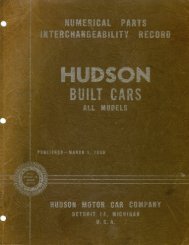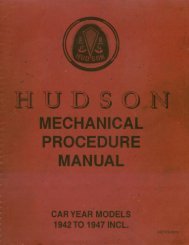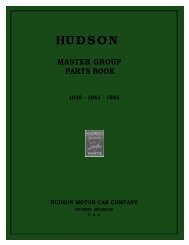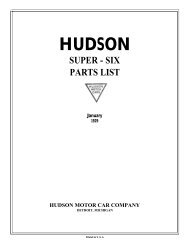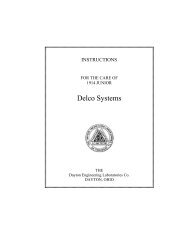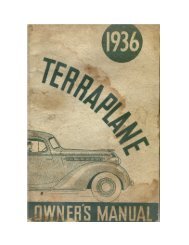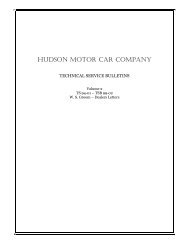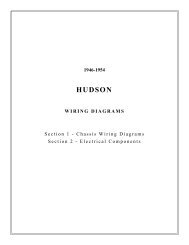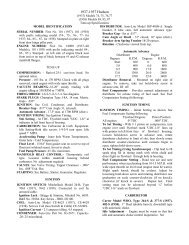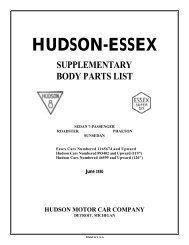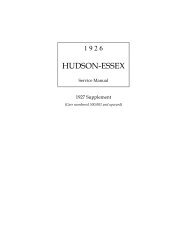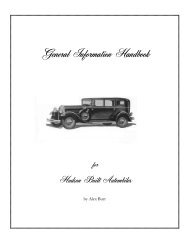1948-1952 Shop Service Manual - - Hudson-Essex-Terraplane Club
1948-1952 Shop Service Manual - - Hudson-Essex-Terraplane Club
1948-1952 Shop Service Manual - - Hudson-Essex-Terraplane Club
You also want an ePaper? Increase the reach of your titles
YUMPU automatically turns print PDFs into web optimized ePapers that Google loves.
5 - 2 COOLING SYSTEM<br />
DESCRIPTION AND OPERATION<br />
The cooling system is of the pressure type and has a<br />
cellular tubular radiator, a centrifugal six vane impeller<br />
pump and a four blade radiator fan with the blades unevenly<br />
spaced to minimize noise.<br />
Six cylinder engine blocks contain a brass water distributing<br />
tube with holes properly spaced to direct the flow of<br />
water around the exhaust valves for cooling purposes.<br />
Eight cylinder engine blocks have a water jacket cover on<br />
the left side of the block.<br />
By-pass thermostats are used to permit rapid. engine<br />
warm-up by restricting circulation of the coolant through<br />
the radiator and by-passing if through the cylinder block<br />
until the coolant temperature rises sufficiently to open the<br />
thermostat. The temperature range of the thermostats is as<br />
follows -<br />
Starts to open 150° to 155.<br />
Fully open at 185°.<br />
RUST AND SCALE DEPOSITS<br />
Scale or rust tends to obstruct the flow of coolant through<br />
the water passages of the cylinder block and radiator, and<br />
when such formation is excessive, it prevents proper heat<br />
dissipation and resultant overheating. This, in turn, causes<br />
loss in lubrication efficiency and accumulation of carbon,<br />
varnish and sludge.<br />
If overheating exists due to clogging of the engine portion<br />
of the cooling system, the condition should be corrected by<br />
the use of a reputable solvent, instead of reverse flushing.<br />
REVERSE FLUSHING<br />
Reverse flushing of the cooling system is the forcing of<br />
water through the radiator using air pressure and flushing in<br />
a direction opposite to that of the normal flow of water.<br />
Reverse flushing is necessary in order to get behind the<br />
deposits and force them out.<br />
The procedure for reverse flushing is as follows:<br />
1. Disconnect hoses from engine.<br />
All models use a pressure type radiator cap which is<br />
designed to maintain a constant pressure in the cooling<br />
system under normal Operating conditions.<br />
A pressurized system provides advantages by protection<br />
against loss of coolant or anti-freeze solutions by evaporation<br />
since the increased pressure of the system raises the<br />
boiling pointof water from a normal 212° F at sea level to<br />
approximately 2300 F with a 7 lb. pressure cap.<br />
CAUTION: When removing pressure cap while the engine is<br />
hot, always turn cap slowly counter clockwise until the stop is<br />
reached. Keep the cap in this position until all pressure is dissipated;<br />
then turn cap fully and remove.<br />
DRAINING SYSTEM<br />
To drain the cooling system, open the radiator drain cock<br />
located at the lower right hand corner and remove the drain<br />
plug in the cylinder block located at the rear left hand side<br />
and remove radiator cap.<br />
FIGURE 1



